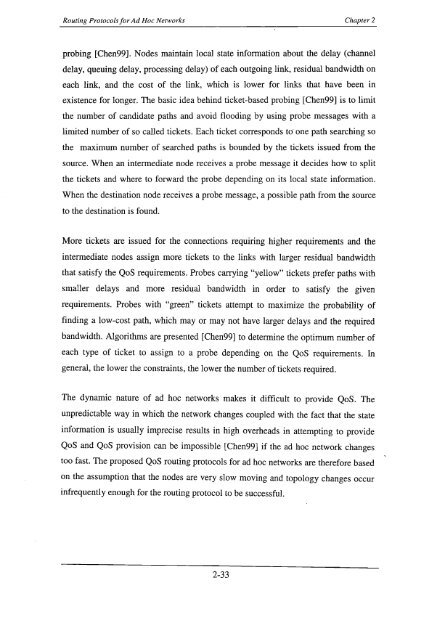Gugrajah_Yuvaan_ Ramesh_2003.pdf
Gugrajah_Yuvaan_ Ramesh_2003.pdf
Gugrajah_Yuvaan_ Ramesh_2003.pdf
You also want an ePaper? Increase the reach of your titles
YUMPU automatically turns print PDFs into web optimized ePapers that Google loves.
Routing Protocols for Ad Hoc Networks Chapter 2<br />
probing [Chen99]. Nodes maintain local state information about the delay (channel<br />
delay, queuing delay, processing delay) of each outgoing link, residual bandwidth on<br />
each link, and the cost of the link, which is lower for links that have been in<br />
existence for longer. The basic idea behind ticket-based probing [Chen99] is to limit<br />
the number of candidate paths and avoid flooding by using probe messages with a<br />
limited number of so called tickets. Each ticket corresponds to' one path searching so<br />
the maximum number of searched paths is bounded by the tickets issued from the<br />
source. When an intermediate node receives a probe message it decides how to split<br />
the tickets and where to forward the probe depending on its local state information.<br />
When the destination node receives a probe message, a possible path from the source<br />
to the destination is found.<br />
More tickets are issued for the connections requiring higher requirements and the<br />
intermediate nodes assign more tickets to the links with larger residual bandwidth<br />
that satisfy the QoS requirements. Probes carrying "yellow" tickets prefer paths with<br />
smaller delays and more residllal bandwidth in order to satisfy the given<br />
requirements. Probes with "green" tickets attempt to maximize the probability of<br />
finding a low-cost path, which mayor may not have larger delays and the required<br />
bandwidth. Algorithms are presented [Chen99] to determine the optimum number of<br />
each type of ticket to assign to a probe depending on the QoS requirements. In<br />
general, the lower the constraints, the lower the number of tickets required.<br />
The dynamic nature of ad hoc networks makes it difficult to provide QoS. The<br />
unpredictable way in which the network changes coupled with the fact that the state<br />
information is usually imprecise results in high overheads in attempting to provide<br />
QoS and QoS provision can be impossible [Chen99] if the ad hoc network changes<br />
too fast The proposed QoS routing protocols for ad hoc networks are therefore based<br />
on the assumption that the nodes are very slow moving and topology changes occur<br />
infrequent!y enough for the routing protocol to be successful.<br />
2-33
















